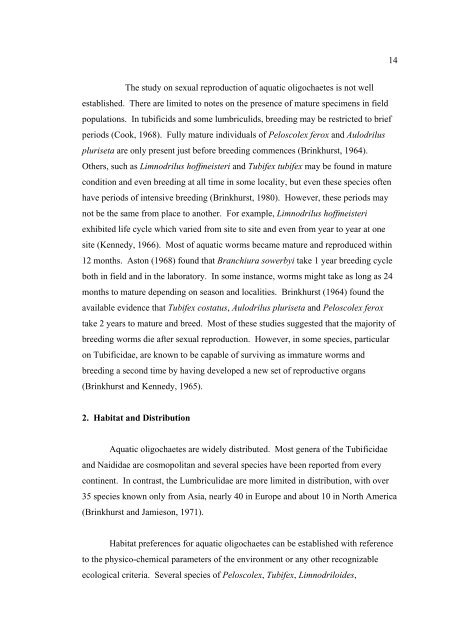THESIS APPROVAL
THESIS APPROVAL
THESIS APPROVAL
Create successful ePaper yourself
Turn your PDF publications into a flip-book with our unique Google optimized e-Paper software.
The study on sexual reproduction of aquatic oligochaetes is not well<br />
established. There are limited to notes on the presence of mature specimens in field<br />
populations. In tubificids and some lumbriculids, breeding may be restricted to brief<br />
periods (Cook, 1968). Fully mature individuals of Peloscolex ferox and Aulodrilus<br />
pluriseta are only present just before breeding commences (Brinkhurst, 1964).<br />
Others, such as Limnodrilus hoffmeisteri and Tubifex tubifex may be found in mature<br />
condition and even breeding at all time in some locality, but even these species often<br />
have periods of intensive breeding (Brinkhurst, 1980). However, these periods may<br />
not be the same from place to another. For example, Limnodrilus hoffmeisteri<br />
exhibited life cycle which varied from site to site and even from year to year at one<br />
site (Kennedy, 1966). Most of aquatic worms became mature and reproduced within<br />
12 months. Aston (1968) found that Branchiura sowerbyi take 1 year breeding cycle<br />
both in field and in the laboratory. In some instance, worms might take as long as 24<br />
months to mature depending on season and localities. Brinkhurst (1964) found the<br />
available evidence that Tubifex costatus, Aulodrilus pluriseta and Peloscolex ferox<br />
take 2 years to mature and breed. Most of these studies suggested that the majority of<br />
breeding worms die after sexual reproduction. However, in some species, particular<br />
on Tubificidae, are known to be capable of surviving as immature worms and<br />
breeding a second time by having developed a new set of reproductive organs<br />
(Brinkhurst and Kennedy, 1965).<br />
2. Habitat and Distribution<br />
Aquatic oligochaetes are widely distributed. Most genera of the Tubificidae<br />
and Naididae are cosmopolitan and several species have been reported from every<br />
continent. In contrast, the Lumbriculidae are more limited in distribution, with over<br />
35 species known only from Asia, nearly 40 in Europe and about 10 in North America<br />
(Brinkhurst and Jamieson, 1971).<br />
Habitat preferences for aquatic oligochaetes can be established with reference<br />
to the physico-chemical parameters of the environment or any other recognizable<br />
ecological criteria. Several species of Peloscolex, Tubifex, Limnodriloides,<br />
14
















